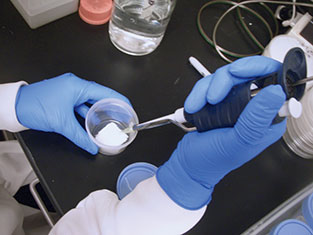
Antibacterial Activity on Textiles
Antimicrobial agents are commonly used to control bacterial growth and unwanted odor on textiles. A proposed new ASTM International standard will aid test laboratories, manufacturers and retailers in understanding which of an array of available standards for antimicrobial treated textiles is best for a given situation.
WK31901, Test Methods and Practices for Evaluating Antibacterial Activity on Textiles, will provide users with an index of procedures in the form of test methods, practices and related documents currently used in the textile industry for determining the antibacterial properties of antimicrobial-treated textile articles.
"Antimicrobial treated textiles have been in the market for 30 years and many test methods exist that can be used to quantitatively and qualitatively measure performance," says Robert A. Monticello, Ph.D., senior scientific consultant, International Antimicrobial Council, and an ASTM member. "Choosing the correct method is extremely difficult as one needs to understand the type of active ingredient that is used and the intended end use."
Monticello notes that currently existing methods are useful, but not in every situation, with methods needing to be modified for each particular end-use and bioactive material. WK31901 will provide directions for modifiying current test methods.
"The modifications may be intended to more closely reflect the end-use scenarios of the treated product, such as towels or athletic wear, or may be needed in order to perform fast, reliable quality control bioassays" says Monticello. "Each of these modifications are generally accepted practices in the industry and currently used by many testing laboratories."
According to Monticello, recent advances in the delivery of the active antibacterial ingredient on textiles has allowed much lower levels of antimicrobial agents to be applied to surfaces, while still demonstrating anti-odor protection.
"With lower active ingredients being used, other opportunities for such treated products are being developed," says Monticello. "Test methods need to be modified to accommodate these new technologies that may have different modes of action or have different end-use expectations."
WK31901 is being developed by Subcommittee E35.15 on Antimicrobial Agents, part of ASTM International Committee E35 on Pesticides, Antimicrobials and Alternative Control Agents.
CONTACT Technical Information: Robert A. Monticello, Ph.D, International Antimicrobial Council • Washington, D.C. • Phone: 202-600-7711 | ASTM Staff: Jennifer Rodgers • Phone: 610-832-9694 | Upcoming Meeting: Oct. 6-9 • October Committee Week • New Orleans, La.
 SN Home
SN Home Archive
Archive Advertisers
Advertisers Masthead
Masthead RateCard
RateCard Subscribe
Subscribe Email Editor
Email Editor